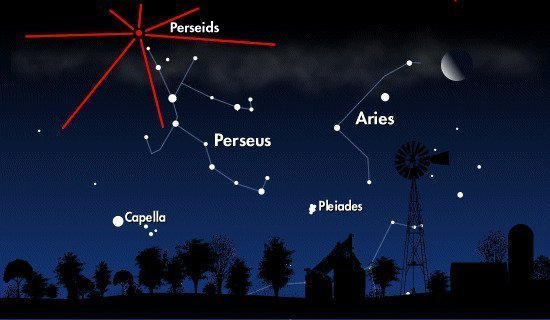Every year at around this time there is a flurry of excitement about the arrival of the Perseids and in particular the weekend when the display should be at its most magnificent. This weekend was the weekend in question and because we tend to get a lot of condensation and mists in the evening I had failed to see anything up till now but on Saturday night it was, to coin a phrase, clear and bright and I woke in the early hours and stepped outside to see what I could see.
The Perseids are a meteor shower that have been observed for around 2000 years. They happen when Earth passes through a cloud of dust left behind Comet Swift-Tuttle. The stream of debris is called the Perseid Cloud.
The name comes from the Greek word Persidai; the sons Perseus in Greek Mythology.
Meteors, also known as shooting stars, are streaks of light in the sky caused by particles falling into our atmosphere and burning up as Earth passes through the debris. During the Perseids peak, there can be up to 60 meteors seen in an hour.
The shower is visible to the naked eye from mid-July every year and peaks from early to mid-August and the best view is from an area with low light pollution. At the time I got up the solar lights were still lit in the garden but even so in the space of about 2 or 3 minutes I managed to see two. I would have stayed longer but the cats were aware of my presence and so all got up and demanded feeding!!!
For information the Comet Swift -Tuttle is a miles-wide behemoth that swings by Earth every 133 years. Swift-Tuttle, whose nucleus is 16 miles wide, is the largest solar system object to pass close to Earth repeatedly. The last time it passed Earth was in 1992.
Like all comets, sometimes called "dirty snowballs" Swift-Tuttle is a ball of dust, ice, rock and dark organic material. It was discovered in July 1862 independently by both Lewis Swift and Horace Parnell Tuttle. The comet orbits the sun, but follows a very steep incline as compared to the solar system planets - driving down into the solar system to whip around the sun and back out again. So when the comet passes Earth it is traveling at great speed and its dust and debris, which create the Perseid meteor shower as they burn up in Earth's atmosphere are travelling quicky too at around 37 miles per second. Even though the comet only passes by Earth every 133 years the meteor shower occurs every year when Earth moves through the trail of its orbit.
The debris comes in faster than many other comets because of its very elongated orbit so that makes the show of meteors more spectacular because of the speed. The Perseids are one of the best meteor showers of the year and has been called the "Fireball Champion" for its record-breaking number of extra-bright meteors called fireballs which are visible even in light-polluted areas.
This year the peak was tipped to be more spectacular than usual reaching 200 meteors an hour because of the effect of Jupiter's gravity on the debris trail.


No comments:
Post a Comment
Note: only a member of this blog may post a comment.